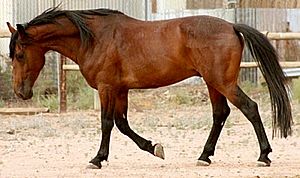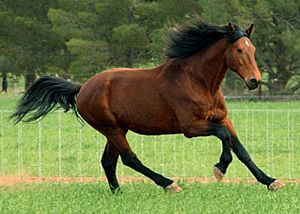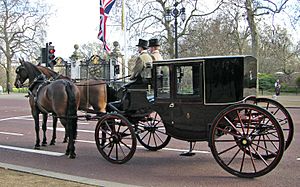Cleveland Bay facts for kids

Cleveland Bays in harness
|
|
| Distinguishing features | Bay in colour, well-muscled, used mainly for driving and fox hunting. |
|---|---|
| Country of origin | England |
| Common nicknames | Chapman Horse |
| Breed standards | |
| Cleveland Bay Horse Society (UK) | Breed standards |
| Cleveland Bay Horse Society of North America | Breed standards |
| Horse (Equus ferus caballus) | |
The Cleveland Bay is a special type of horse from England. It started in the 1600s. This horse is named after its color, which is always bay, and the Cleveland area in Yorkshire where it first appeared.
Cleveland Bays are strong and muscular horses. They have powerful, but short, legs compared to their body. They are always bay, meaning they are brown with a black mane, tail, and lower legs. Sometimes, a few light hairs in their mane or tail are a sign of a purebred Cleveland Bay. It is the oldest horse breed that started in England.
Long ago, during the Middle Ages, the ancestors of these horses were used as pack horses to carry goods. People called them "Chapman Horses." Later, these horses were bred with other breeds like Andalusian, Barb, Arabian, and Thoroughbreds. This mixing created the Cleveland Bay we see today. Over time, they became lighter and faster. This made them better for pulling carriages and for riding.
The Cleveland Bay's popularity has changed a lot since it first came to the United States in the early 1800s. After World War II, there were very few left. But since the 1970s, more people have become interested in them again. Even so, they are still quite rare, with only about 550 horses in the world as of 2006.
The Royal Family has always liked these horses. They still use them today to pull carriages in royal parades. Cleveland Bays have also helped create and improve other horse breeds. Today, they are used for farm work, driving, and riding. They are very good at fox hunting and show jumping, especially when they are mixed with Thoroughbreds. Because they are so rare, groups like the Rare Breeds Survival Trust in the UK and Livestock Conservancy in the US say they are close to extinction.
Contents
What Makes a Cleveland Bay Special?
The Cleveland Bay usually stands between 16 and 16.2 hands tall. They are always bay in color. Breeders prefer bright bay horses, which have a reddish tint. Regular bay, dark bay, and light bay are also common.
A small white star on their forehead is usually the only white marking allowed. Any other white markings mean the horse cannot be officially registered. Their lower legs must be completely black. If their legs are red below the knees and hocks, it's seen as a fault, but the horse can still be registered. This color rule helps make it easy to find matching horses for driving teams.
Body and Movement
Cleveland Bays have a large head and a strong, well-muscled neck. Their chest is wide and deep, and their shoulders are muscular. Their legs are short compared to their body but are very strong. They have very little hair, called "feather," on their lower legs. This is because they were bred to work in muddy fields, where too much feathering could cause health problems.
These horses are tough and live a long time. They also have a calm and gentle personality. In the early 1900s, rules were made about how Cleveland Bays should move, especially at the trot. A good trot was important because these horses were also used for pulling artillery in the military. Horses with a good trot often have a talent for jumping. This makes them great for show jumping, eventing, and steeplechase races, especially when they are crossed with Thoroughbreds.
Part-Bred Cleveland Bays
Sometimes, Cleveland Bays are bred with other horses. These horses are called Cleveland Bay Sporthorses or part-breds. They can be registered with a special registry for part-bred horses. To be registered, at least one of their grandparents must be a purebred Cleveland Bay.
History of the Cleveland Bay
The Cleveland Bay is from the Cleveland area of Yorkshire, England. It is known as the oldest horse breed native to Britain that is not a heavy draft horse.
How the Breed Grew
The British Cleveland Bay Horse Society was started in 1883. The first book listing all the registered horses came out in 1884. In the 1800s, many Cleveland Bays were sent to other countries like Australia, New Zealand, the United States, and Europe.
In the early 1800s, the first Cleveland Bays came to the United States. In 1884, a horse show was started in Virginia to show off these horses. The Cleveland Bay Society of America was formed in 1885. By 1907, over 2,000 horses were registered in the US. Even Buffalo Bill Cody used four Cleveland Bay stallions in his Wild West Show.
Before World War I, Britain needed more cavalry horses. Smaller Cleveland Bays carried soldiers, and larger ones pulled artillery. The British War Office even paid extra for Cleveland Bay stallions. Many horses were lost during the war. After the war, in the 1920s, the British society allowed some unregistered mares to be added to the breed list if they looked like Cleveland Bays. Even King George V bred some of these horses.
Decline and Comeback
However, fewer people wanted Cleveland Bays as machines took over horse work. The Great Depression in the 1930s also reduced sales. After World War II, the number of Cleveland Bays dropped even more. By 1962, there were only four purebred stallions left in the UK.
Queen Elizabeth II helped save the breed. She bought a stallion named Mulgrave Supreme, who was about to be sold to the United States. She bred him with purebred and part-bred mares. Within 15 years, there were 36 purebred stallions in the UK. Prince Philip, Duke of Edinburgh, also used Cleveland Bays for many years in international driving competitions.
In the late 1960s and 1970s, interest in the breed grew again. Part-bred Cleveland Bays became popular for riding, especially as hunters and jumpers. A Cleveland Bay/Thoroughbred cross even competed in show jumping at the Tokyo Olympics in 1964. Other part-bred Cleveland Bays also competed in the Olympics. Horses continued to be sent to many countries, including Japan, the United States, and Australia.
Since 1977, Queen Elizabeth II has supported the Cleveland Bay Society. In 1984, she was its president. The US Cleveland Bay Society was restarted in 1985. Today, both the US American Livestock Breeds Conservancy and the UK Rare Breeds Survival Trust say the breed is in a "critical" state. This means there are very few breeding horses left in the world. In 2006, there were only about 550 Cleveland Bay horses worldwide.
What Are Cleveland Bays Used For?

The Cleveland Bay is a very useful horse. Today, they are still used for many things, like driving carriages and farm work. In the 1920s, Cleveland Bays started being used in the British royal stables. Both purebred and mixed Cleveland Bays are still used as royal carriage horses today.
These horses are also great for fox hunting. They are strong and can carry a person weighing 250 pounds (113 kg) all day, jumping over obstacles and through tough mud. When they are bred with Thoroughbreds, the new horses are lighter and faster, but still strong.
Cleveland Bays were among the first stars when show jumping began in the mid-1800s. Two mares, Star and Fanny Drape, were famous jumpers. Fanny Drape was known to jump over a 6-foot (1.8 m) stone wall with a rider!
In 2006, a Cleveland Bay stallion named Tregoyd Journeyman was used as a model for a new horse toy by Breyer Animal Creations. Purebred and crossbred Cleveland Bays make up most of the bay horses in the Royal Mews, which are the British royal stables. There, they get special training to get used to loud noises and crowds before they pull royal carriages.
The Cleveland Bay also helped create other horse breeds, like the Oldenburg, Holstein, and Hanoverian breeds. This is because of their strength, stamina, and jumping ability. In the late 1700s, the Cleveland Bay was crossed with Thoroughbreds to create the Yorkshire Coach Horse. These horses were used to pull mail and passenger coaches. In the 1800s, the Cleveland Bay was also bred with French and Belgian draft horses to create the Vladimir Heavy Draft, a strong Russian breed.
Images for kids
See also
 In Spanish: Cleveland Bay para niños
In Spanish: Cleveland Bay para niños





